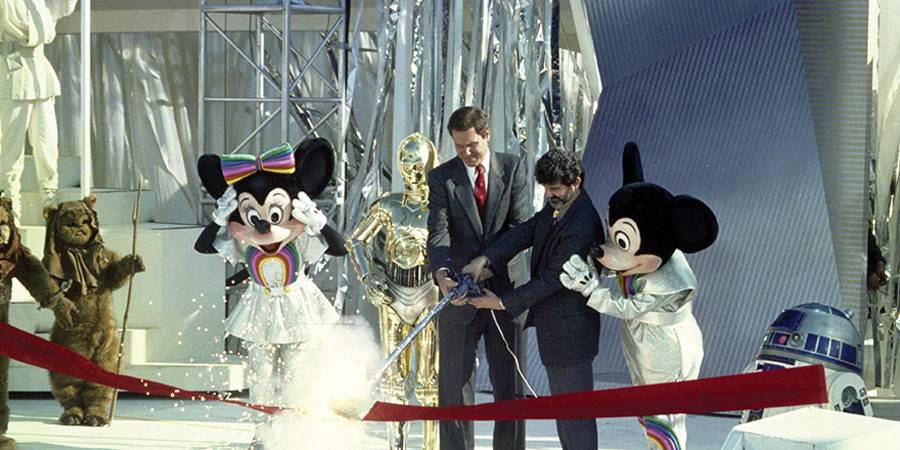The Imagineering Story Miniseries: Ep 3 - The Midas Touch

In this episode we follow the new leadership of Michael Eisner and Frank Wells as they bring life back into the imagineering team. Creating a period of tremendous growth for the company. This was the first time outsiders were selected for executive positions including CEO and president. The pair came in at just the right time as the company was crumbing. The imagineering team wasn’t the only area in Disney that was experiencing cutbacks and layoffs.
Frank and Micheal didn’t know anything about imagineering and the parks. Yet, they were very eager to learn and understand this key part of the company. The imagineers at the time believed that their days at Disney were numbered. What they didn’t know was that Eisner and Wells saw great potential in the imagineering department and the future of the theme parks. In fact when Eisner came to meet the imagineering team he called it the “crown jewel” of Disney, which was a big shock to the department.
Michael, knowing nothing about theme parks, brought his 14 year old son to the park to get his view of the park. His son loved star wars and when he saw their ideas for a star wars themed ride, Michael decided that was what they were going to do.

Star Tours was the first ride not based on a Disney movie. For the ride they utilized pilot training technology that mimicked the feeling of flight. The ride was a huge success drawing in a number of guests so large that they would wait for up to four hours. The ride was one of the first truly immersive experiences combining film and ride. From here on out rides would become more integrated with media to create the ideal experience.


Eisner wanted to create a smaller park with the theme of a Hollywood studio back-lot tour. They wanted to recreate the feel of classic Hollywood. They took stories from the silver screen to help bring new rides to the park based on popular movies. This project excited the Imagineers and Eisner spent most of his time in imagineering. He truly loved the energy that was created and working with the theme parks. They described Micheal Eisner as a kid at a candy store. Hollywood Studios began as a small half day attraction and seemed to have become bigger every time Micheal visited the park.
In the year 1990, Disney embarked on its next international endeavor… Euro Disneyland. Located just outside of Paris, France. They wanted to make it the most detailed and beautiful of all the Disney parks. Wanting to both maintain their brand and incorporate the French culture. However, the Disney company didn’t do their research when it came to what the people of France wanted. The people didn’t want the North American influence in Europe. Paris boycotted the park. When the stock debuted on the Paris exchange the people chanted “Mickey go home” and threw eggs at Eisner.
In Euro Disneyland, they incorporated stained glass windows and tapestries that were made by traditional crafts men and women.They used colourful shingles and when designing the castle used lighter paint on the top and darker paint on the bottom to make it appear taller.


Disneyland Paris was hated by critics and loved by the French people, however it seemed as though they didn’t want to admit it. They didn’t want it because it wasn’t them. An economic recession and bad press led to low attendance that Disney was not expecting. They spent too much money and built too many hotel rooms. Their other problem was they were charging the same fee as they do at Disney World, which Eisner called stupid for expecting that. Euro Disney almost went bankrupt and it was then that the name was changed to Disneyland Paris.
Frank Wells and Micheal Eisner were the perfect duo, creating a great balance. In April of 1994, Frank Wells was killed in a helicopter crash. He was someone that was so close to imagineering and a strong leader. His life and time at Disney has been commemorated in the tribute window street display that captures his love of adventure.

Imagineering’s creativity once again took a hit. The company began to look more logically than artistically. It became ‘do we need this?’ instead of ‘do we want this?’. Everything they did suddenly needed a purpose. The theme parks felt done.
I enjoyed this episode because it really highlighted the transition between old Disney and the Disney we know today. The episode really shows the fun of imagineering and the creative process. Disney’s imagineering team had an unparalleled energy to it. Simply no other workplace is like this. Everyone loved what they were doing and even though Eisner made some mistakes I think he recreated the Disney parks. He picked it back up when it was falling down and combined the movie world and theme parks. As for Disneyland Paris, it was kind of a nightmare at the time that I think in today's world paid off.

Comments
Post a Comment